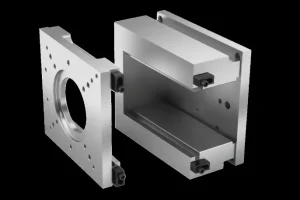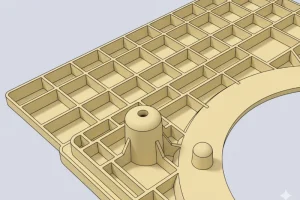Introduction: Mold injection molding is a way to make a lot of parts that are the same shape. Here’s how it works: You heat up plastic and then push it into a mold with a machine. The plastic cools down and gets hard, and then you have a part.
The injection mold has two parts: the moving mold and the fixed mold. The moving mold is installed on the moving template of the injection molding machine, and the fixed mold is installed on the fixed template of the injection molding machine.

When injection molding, the moving mold and the fixed mold are closed to form a pouring system and a cavity. When the mold is opened, the moving mold and the fixed mold are separated to remove the plastic product. This article will discuss in detail which variables affect the cost of injection molds and their solutions.
What Does an Injection Mold Consist of?
Plastic molds are divided into several parts based on their function, including: pouring system, temperature control system, molding part system, exhaust system, guide system, ejection system, etc.

Among them, the pouring system and molding parts are the parts that are in direct contact with the plastic, and they change with the plastic and the product. They are the most complex and most variable parts in the mold, and require the highest processing finish and precision.
The Pouring System
refers to the flow channel part before the plastic enters the cavity from the nozzle, including the main channel, cold material hole, branch channel, and gate, etc.

The Molding Parts System
refers to the combination of various parts that make up the shape of the product, including the movable mold, fixed mold, and cavity (concave mold), core (convex mold), molding rod, etc.
The core forms the inner surface of the product, and the cavity (concave mold) forms the outer surface shape of the product. After the mold is closed, the core and cavity make up the mold cavity.

According to the process and manufacturing requirements, sometimes the core and the concave mold are made up of several pieces, and sometimes they are made into one piece, and only inserts are used in parts that are easy to damage and difficult to process.
Thermostatic System
To meet the requirements of the injection process for mold temperature, a thermostatic system is needed to adjust the mold temperature. For injection molds for thermoplastics, the main thing is to design a cooling system to cool the mold (the mold can also be heated).

The common method of mold cooling is to open a cooling water channel in the mold and use circulating cooling water to take away the heat of the mold; in addition to using cooling water to pass hot water or hot oil, electric heating elements can also be installed inside and around the mold to heat the mold.
Exhaust System
It is set up to exhaust the air in the cavity and the gas generated by the melting of plastic during the injection molding process to the outside of the mold.

If the exhaust is not smooth, the surface of the product will form gas marks (gas marks), burns and other defects; the exhaust system of the plastic mold is usually a groove-shaped air outlet opened in the mold to exhaust the original cavity air and the gas brought in by the molten material.
When the molten stuff is shot into the hole, the air that was in the hole and the air that came in with the stuff has to get out of the hole through the hole at the end of the hole where the stuff goes, or else the thing will have holes, bad connections, not enough stuff, and maybe the air will get squished and get hot and burn the thing.

Usually, the hole can be at the end of the hole where the stuff goes or on the place where the two halves of the hole come apart.
The second is to open a shallow groove with a depth of 0.03-0.2mm and a width of 1.5-6mm on one side of the die. During injection, there will not be much molten material leaking out of the vent hole, because the molten material will cool and solidify there and block the channel.

The vent opening should not be facing the operator to prevent the molten material from accidentally spraying out and injuring people. In addition, the clearance between the ejector rod and the ejector hole, the clearance between the ejector block and the stripper plate and the core can also be used to exhaust.
Guide System
To make sure the movable mold and the fixed mold can be aligned accurately when the mold is closed, a guide component must be set in the mold.

In the injection mold, four sets of guide pins and guide sleeves are usually used to form the guide component. Sometimes, inner and outer conical surfaces that match each other are set on the movable mold and the fixed mold to help with positioning.
Ejector System
Typically includes: ejector, front and rear ejector plates, ejector guide rod, ejector return spring, ejector plate locking screw, and other components.

After the part is molded and cooled in the mold, the front and rear halves of the mold separate and open, and the ejection system—the ejector pin—pushes the plastic part and the solidified material in the runner out of the mold cavity and runner location under the push of the ejector rod of the injection molding machine, so the next injection molding cycle can begin.

What are the Categories of Injection Molds?
There are a few different types of injection molds. The most common ones are two-plate molds, three-plate molds, hot runner molds, and right-angle injection molds.
Two-Plate Mold
The two-plate mold is also called a single-parting surface injection mold. It is the simplest and most basic mold type. It is widely used and can be designed into a single-cavity mold or a multi-cavity mold according to product requirements.

Three-Plate Mold
The three-plate mold is also a double-parting surface injection mold. It is different from the single-parting surface injection mold. In the fixed mold part, the three-plate mold of this mold is designed with a stripper plate that can be partially moved.

In this design, the runner will be ejected between the first and second plates, and the stripper plate will be ejected between the second and third plates to achieve the purpose of separating the part and the runner.
Double parting surface injection molds are not suitable for molding large injection molded parts because they have complex structures, high manufacturing costs, and difficult parts processing.

Hot Runner Molds
Hot runner molds are similar to traditional cold runner molds. The difference is that hot runner molds directly inject plastic into the cavity through a nozzle. There is no runner during the molding process, which greatly improves the utilization rate of raw materials and avoids waste.

In general, the manufacturing cost of hot runner molds is higher than that of cold runner molds, but if the molded parts are very small, especially if the parts are smaller than the runner, hot runner molds are a more economical choice.
Right-Angle Injection Nolds
Right-angle injection molds are not widely applicable and are only suitable for angle injection molding machines. Unlike other injection molds, during molding, the feeding direction of the mold must be perpendicular to the opening and closing direction, and the cross-sectional area is usually unchanged.

In addition, the main channel of the right-angle injection mold is opened on both sides of the moving and fixed mold parting surface. At the end of the main channel, a replaceable runner insert is set to prevent wear and deformation between the injection molding machine nozzle and the main channel inlet end.
What Variables Affect the Cost of Injection Molds?
Part Materials
The type of material you use for your injection molded parts will greatly affect the cost of your injection molds. Certain materials may require specific mold features, cooling channels or surface treatments due to their unique qualities and requirements.

Some plastic materials, especially those that are high temperature or abrasive, will wear injection molds and shorten tool life. To overcome this challenge, harder molds made of specific grades of steel are needed, which increases the cost of plastic injection molds.
Part Finishing
From my years of experience in manufacturing specialized injection molded parts for luxury consumer products, I’ve found that the amount of finishing required for these parts always has a huge impact on the cost of plastic injection molding itself plastic injection molding process.

As part finishing gets more complex, injection molding gets harder. To make it work, you have to think about finishing when you design the mold and plan production. To get the finish you want every time, you need the right mold materials and you have to put in fancy mold features. All of that costs more money to make the mold.
Processing Costs
Making injection molds involves many processes, such as milling, turning, grinding, wire cutting, etc. Each process takes time and manpower, which will affect the plastic injection molding costs of the mold. The calculation of processing costs is usually based on the manufacturer’s equipment and technology level, as well as the required processing time.

Design and Engineering Costs
The design and engineering of injection molds also require certain costs. This includes the salary of mold designers, the cost of design software and engineering equipment, and the cost of testing and verifying molds. These tooling costs are also an important part of calculating mold costs.
Life And Durability
The life and durability of the mold is a big factor in the price of the mold. Generally, the design and quality of the mold determine how long it will last. High-quality molds can usually be used longer, but they cost more.

Complexity And Size
The price of the mold is also affected by its complexity and size. The more complex the mold design and manufacturing, the more time and resources it takes, and the higher the cost. In addition, the size of the mold also affects the amount of material required and the difficulty of processing, which affects the cost.
Quantity and Batch
The number and production batch of injection molds are also factors that affect the cost. Generally, the mold cost of mass production will be lower because the unit cost can be reduced by allocating fixed costs. The mold cost of small batch production will be relatively high because the economies of scale cannot be fully utilized.

Product Design
Product design can change the mold. For example, after the mold design is completed, the frame should be ordered after placing an order, and the customer’s design changes. Then if the change is relatively small, it will not affect the overall structure.

If there are many changes, it will affect the products produced by the mold, and even the frame needs to be re-ordered. The cost will increase greatly.
Is the Mold Design Appropriate, Reasonable, And Feasible?
There are many simulation methods, such as manufacturing process analysis, structural dynamics analysis, three-dimensional comparative analysis of test products and design products, etc. If the mold design is unreasonable, the cost will increase.

Control the Number of Trials for Mold Manufacturing
Most manufacturers will calculate the cost of making a mold by the number of days it takes to send the mold to the customer. If the mold cannot be delivered after multiple inspections, then in addition to the fines stipulated in the contract, the longer the mold stays in the factory, the higher the processing cost. Of course, the cost of mold testing will also be relatively high.
How to Reduce the Cost of Injection Molds?
Choose the Right Material
The first thing you need to do to reduce the cost of plastic mold manufacturing is to choose the right material.

First, choose the right material based on the requirements of the mold and the expected production volume.
Second, compare and evaluate multiple materials to find ones that are reasonably priced and have stable performance.
Finally, make sure the materials you choose are of good quality so that the mold will last and be cost-effective.

Optimize Design
Design optimization is one of the important ways to reduce the cost of plastic mold manufacturing. Through design optimization, material waste can be reduced, and the service life and quality of the product can be improved.

At the same time, for molds that have been designed, by improving the details and optimizing the structural design, the purpose of increasing the service life of the mold and reducing the manufacturing cost can be achieved.
Strengthen Management
The key to reducing the cost of plastic mold manufacturing is to strengthen management. In the process of mold manufacturing, it is necessary to establish a complete quality management system, strengthen supplier management, production plan management, and cost control management, and fully control all links in the mold production process to ensure the quality and efficiency of the manufacturing process.

Improve the Level of the Process.
Improving the process level is also an important measure to reduce the cost of plastic mold manufacturing. By introducing advanced production processes and technical equipment, we can improve manufacturing efficiency and quality levels.

At the same time, we can reduce operating time and losses caused by manual operation omissions in the manufacturing process. Through effective technical means, we can control the increase in manufacturing costs and optimize the development strategy of the enterprise.
Lean Production Management
Using lean production management is a good way to cut the cost of making plastic molds. When you use lean production management, you can use all the resources of your company to make molds, cut down on waste in the production process, and make more molds faster and better.

You can also make your company work better, cut down on how much it costs to run your company, and make more molds faster and better.
In short, every manufacturing company needs to solve the problem of reducing the cost of plastic mold manufacturing. Only when the company gradually improves its own management and technical system and establishes a stable cost reduction system can the company improve its production efficiency and competitiveness and achieve sustainable development.

Effective Use of Plastic Molds
Before producing goods, carefully selecting plastic molds with scientific and reasonable design schemes is the most basic way to control injection molding cost. Different types of stamping mold structures have different requirements for product raw materials, of course. Excellent molds have high output rates, resulting in less waste, and of course low production costs.
Using scientific and reasonable processing technology .

For the same product, different types of production and processing technologies are used, and the required raw materials are different. According to the product characteristics, under the premise of meeting the quality standards, the application of improved processing technology can effectively reduce material and production costs.
Establish an Effective Quality Management System
Setting up a good quality management system is another way to low cost injection molding of making injection molds. When you have a good quality management system, you can cut down on mistakes and duplication in manufacturing, which will make your production more efficient and better.

For example, you can use quality assurance software to help you manage quality and avoid mistakes and duplication in manufacturing. Also, when you have a good quality management system, you can make your customers happier, which will help you sell more and make more money.
Conclusion
This article is about the factors that affect the cost of injection molding and their solutions. First, the cost of the mold injection molding material is the main factor affecting the cost. Different types and complexities of molds require different metal materials, so the cost is different.

Second, the cost of processing and design engineering also has a significant impact on the cost. Each processing step in the mold manufacturing process requires time and resources.
In addition, the complexity, size, and expected production batch of the mold will also directly affect the cost level.

The article points out that by selecting appropriate materials, optimizing design, strengthening management, improving process level, and adopting lean production management, the manufacturing injection mold costs can be effectively reduced, production efficiency and quality level can be improved, thereby promoting the sustainable development of enterprises.If you have any injection molding project, please contact Zetar Mold









